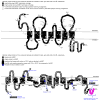The solute carrier family 10 (SLC10): beyond bile acid transport
- PMID: 23506869
- PMCID: PMC3602841
- DOI: 10.1016/j.mam.2012.07.004
The solute carrier family 10 (SLC10): beyond bile acid transport
Abstract
The solute carrier (SLC) family 10 (SLC10) comprises influx transporters of bile acids, steroidal hormones, various drugs, and several other substrates. Because the seminal transporters of this family, namely, sodium/taurocholate cotransporting polypeptide (NTCP; SLC10A1) and the apical sodium-dependent bile acid transporter (ASBT; SLC10A2), were primarily bile acid transporters, the term "sodium bile salt cotransporting family" was used for the SLC10 family. However, this notion became obsolete with the finding of other SLC10 members that do not transport bile acids. For example, the sodium-dependent organic anion transporter (SOAT; SLC10A6) transports primarily sulfated steroids. Moreover, NTCP was shown to also transport steroids and xenobiotics, including HMG-CoA inhibitors (statins). The SLC10 family contains four additional members, namely, P3 (SLC10A3; SLC10A3), P4 (SLC10A4; SLC10A4), P5 (SLC10A5; SLC10A5) and SLC10A7 (SLC10A7), several of which were unknown or considered hypothetical until approximately a decade ago. While their substrate specificity remains undetermined, great progress has been made towards their characterization in recent years. Explicitly, SLC10A4 may participate in vesicular storage or exocytosis of neurotransmitters or mastocyte mediators, whereas SLC10A5 and SLC10A7 may be involved in solute transport and SLC10A3 may have a role as a housekeeping protein. Finally, the newly found role of bile acids in glucose and energy homeostasis, via the TGR5 receptor, sheds new light on the clinical relevance of ASBT and NTCP. The present mini-review provides a brief summary of recent progress on members of the SLC10 family.
Copyright © 2012 Elsevier Ltd. All rights reserved.
Figures


 ) are highlighted. Alignment of hASBT with other mammalian species, namely, orangutan, dog, wild boar, mouse, rat, hamster and rabbit were compared and are represented here as one letter amino acid codes, enclosed in black circles for identical, gray circles for highly similar and white circles for nonconserved residues. These sequences were also retrieved from NCBI, under the RefSeq ID’s: orangutan (Pongo abelii; NP_001125080.1), dog (Canis lupus familiaris; NP_001002968.1), wild boar (Sus scrofa; NP_001231392.1), mouse (Mus musculus; NP_035518.1), rat (Rattus norvegicus; NP_058918.1), hamster (Cricetulus griseus; NP_001233749.1) and rabbit (Oryctolagus cuniculus; NP_001076233.1). B, Secondary structure of 3ZUY (derived from (Hu et al., 2011) supplementary Fig. 5), highlighting its 10 TMs, Ncyt/Ccyt orientation and amino acids reputedly relevant for transport of sodium (Q77, E260 and Q264) and bile acid (N295). Amino acids that differ between 3ZUY, Q9K0A9 (i.e., native ASBT in MC58 Neisseria meningitis), and the mutant employed to generate the crystal structure, 3ZUX, based on ClustalW alignment, are also indicated. Amino acids in 3ZUY were aligned with hASBT, and are indicated by black circles for identical, gray circles for highly similar and white circles for non-conserved residues.
) are highlighted. Alignment of hASBT with other mammalian species, namely, orangutan, dog, wild boar, mouse, rat, hamster and rabbit were compared and are represented here as one letter amino acid codes, enclosed in black circles for identical, gray circles for highly similar and white circles for nonconserved residues. These sequences were also retrieved from NCBI, under the RefSeq ID’s: orangutan (Pongo abelii; NP_001125080.1), dog (Canis lupus familiaris; NP_001002968.1), wild boar (Sus scrofa; NP_001231392.1), mouse (Mus musculus; NP_035518.1), rat (Rattus norvegicus; NP_058918.1), hamster (Cricetulus griseus; NP_001233749.1) and rabbit (Oryctolagus cuniculus; NP_001076233.1). B, Secondary structure of 3ZUY (derived from (Hu et al., 2011) supplementary Fig. 5), highlighting its 10 TMs, Ncyt/Ccyt orientation and amino acids reputedly relevant for transport of sodium (Q77, E260 and Q264) and bile acid (N295). Amino acids that differ between 3ZUY, Q9K0A9 (i.e., native ASBT in MC58 Neisseria meningitis), and the mutant employed to generate the crystal structure, 3ZUX, based on ClustalW alignment, are also indicated. Amino acids in 3ZUY were aligned with hASBT, and are indicated by black circles for identical, gray circles for highly similar and white circles for non-conserved residues.
References
-
- Ananthanarayanan M, Li Y, Surapureddi S, Balasubramaniyan N, Ahn J, Goldstein JA, Suchy FJ. Histone H3K4 trimethylation by MLL3 as part of ASCOM complex is critical for NR activation of bile acid transporter genes and is downregulated in cholestasis. Am J Physiol Gastrointest Liver Physiol. 2011;300 (5):G771–781. - PMC - PubMed
-
- Annaba F, Ma K, Kumar P, Dudeja AK, Kineman RD, Shneider BL, Saksena S, Gill RK, Alrefai WA. Ileal apical Na+-dependent bile acid transporter ASBT is upregulated in rats with diabetes mellitus induced by low doses of streptozotocin. American journal of physiology. Gastrointestinal and liver physiology. 2010b;299 (4):G898–906. - PMC - PubMed
Publication types
MeSH terms
Substances
Grants and funding
LinkOut - more resources
Full Text Sources
Other Literature Sources
Molecular Biology Databases
Miscellaneous

